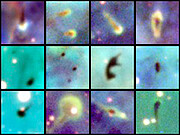Substantial Population of Stellar Cocoons Found in Surprisingly Harsh Environment
8 January 2003
Astronomers have discovered dozens of potential stellar cocoons within the hostile environment of the Carina Nebula, including some oddballs with bulbous heads, irregular shapes and long, thin tails. Each of these objects may harbor disks of gas and dust that could one day form planetary systems.
This is the first large population of these so-called ‘proplyd’ objects to be found outside of the Orion Nebula, the closest region to Earth known to be forming massive stars. The newly discovered proplyds located within the Carina Nebula (NGC 3372) are five times farther from Earth than Orion, in a separate spiral arm of the Milky Way galaxy.
“These intriguing proto-planetary systems in the Carina Nebula are located near several of the hottest and most massive stars known in the Milky Way,” says Nathan Smith of the University of Colorado in Boulder, lead author of a study released today in Seattle at the 201st meeting of the American Astronomical Society. “This suggests that planetary disks may be more resilient or more common than previously thought.”
Detected from the ground using the National Science Foundation’s 4-meter Blanco telescope at Cerro Tololo Inter-American Observatory (CTIO) in Chile, the proplyds in Carina are puzzling for several reasons.
For one, they are typically five to ten times larger than similar objects in Orion, which were found (and have been studied extensively) using the Hubble Space Telescope (HST). "One explanation for this peculiar situation may be that the Carina proplyds have more massive proto-planetary disks than those in Orion, since the whole region of Carina tends to give birth to more massive stars,” explains John Bally, co-author of the paper from the University of Colorado, along with Smith, Jacob Thiel and Jon A. Morse.
The proplyds detected in Carina range in size from 2,000-10,000 Astronomical Units, though smaller objects beyond the resolution limit of the Blanco telescope may certainly exist; an Astronomical Unit is equivalent to 150 million kilometers (93 million miles). In other words, the large proplyds in Carina are typically 100 times the diameter of our solar system.
In addition, while some Carina proplyds closely resemble those in Orion, others in Carina have relatively large, spherical heads and thin tails, and at least one appears to have two tails, which actually may turn out to be bipolar jets once sharper images are obtained.
Located in the Southern Hemisphere sky at a distance of 7,300 light-years from Earth, the Carina Nebula is home to the famous massive star Eta Carinae, as well as about 60 other very hot, massive stars. The discovery of so many proplyds in the Carina Nebula was unexpected because the conditions are much more extreme there than in Orion, meaning proplyds should evaporate faster as they are baked in the ultraviolet radiation from such hot, massive stars.
“Most normal stars like our Sun form in violent ‘starburst’ regions along with much more massive stars—an environment more like the Carina Nebula than Orion,” Smith says. “A better understanding of these objects in Carina should tell us more about the prospects for survival of early planetary systems. Such knowledge could also help us diagnose the earlier radiation history of Eta Carinae, before it erupted and ejected material that now enshrouds the star.”
The uniquely wide field of view offered by the Mosaic camera on the CTIO 4-meter telescope enabled this discovery. Each snapshot with this instrument covers an area of sky larger than the full Moon with high spatial resolution, allowing for much more efficient sky coverage than the narrower field of view offered by HST.
“More intensive imaging and spectroscopy are needed with the sharper view of HST to see if these objects really are proplyds like those in Orion, and to look for smaller ones, comparable in size to those in Orion, to determine if they too can survive in the less hospitable environment near Eta Carinae,” Smith adds.
A paper on the discovery of numerous proplyds in the Carina Nebula by Smith, Bally, Thiel and Morse has been submitted for publication in the Astrophysical Journal Letters.
More information
These observations were supported by the National Science Foundation and NASA. CTIO is part of the National Optical Astronomy Observatory (NOAO), which is operated by the Association of Universities for Research in Astronomy (AURA), Inc., under a cooperative agreement with the National Science Foundation.
Links
- A 12-frame sample image of the Carina proplyds, shown at the top of this press release, is available above.
- A colorful narrow-band emission line image of the entire Carina Nebula taken by Smith is available at:
http://www.noao.edu/image_gallery/html/im0667.html.
Contacts
Douglas Isbell
Public Information OfficerNational Optical Astronomy Observatory
Tel: 520/318-8214
Email: disbell@noao.edu
Jim Scott
University of Colorado News Service
Tel: 303/492-3114
Email: jim.scott@colorado.edu
About the Release
| Release No.: | noao0301 |
| Legacy ID: | NOAO 03-01 |
| Name: | Carina Nebula |
| Facility: | Víctor M. Blanco 4-meter Telescope |
| Science data: | 2003ApJ...587L.105S |



